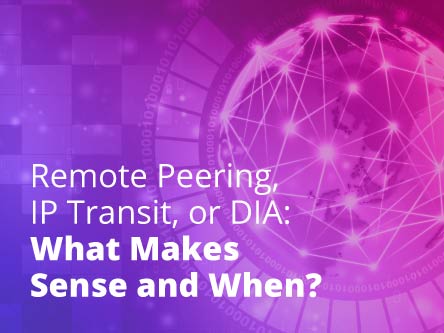Remote Peering vs Direct Peering
In this article we will explain the differences between remote peering vs direct peering and list down the pros and cons of each peering strategy. Discover whether remote or direct peering is best for your global internet and connectivity strategy.
What Is Peering?
What is peering and what makes it so substantial to the global reach of the internet? Peering takes place when internet service providers (ISPs), content providers or carriers open their networks to each other and exchange traffic together.
What is key here is that both providers are dependent on each other’s networks. Hence, to benefit both networks and its users, it makes sense to establish a peering connection. By establishing a connection between the networks, the transmission of data and exchange of content can run freely and unobstructed. This enhances the internet user experience as there is less delay.
Peering is in most cases based on a free service. In some cases, one party may pay to the other party it wants to peer with.
The Difference between Remote Peering and Direct Peering
If peering is a direct connection between two networks, what is then the difference between remote peering and direct peering?
Remote peering takes place when parties establish a peering relationship (virtually) from a distance via an internet exchange. What is key here is that both networks are not physically located in the same internet exchange (IX) point or building, for example a data centre. Remote peering is established via the platform of an internet exchange, by connecting both networks together on the internet exchange via remote connections.
With direct peering both ISPs and carriers are already located in the same facility. They are able to physically interconnect both network platforms. For example, via a fibre connection to the exchange which is also located in the exact same building. Or via a data centre fibre cross-connect which physically interconnects both networks in the same building.
The Pros and Cons of Direct Peering
Direct peering has many pros and advantages vs remote peering. Because of the physical infrastructure connecting two networks and the direct control network administrators have over the equipment which reduces unauthorised access and tampering risks, direct peering is considered to be more secure than remote peering.
ISPs, content providers and carriers that have direct peering relationships are also less dependent on other external networks and connections. This makes the network performance of direct peering more stable, easier to establish and operate compared to remote peering.
On the other hand, there are also cons and disadvantages of direct peering. One important disadvantage is the requirement to constantly be present in the exact same location as the target network to peer with. This additional complexity will lead to higher network and data centre operating costs.
If customers have a global network strategy a full direct peering strategy is almost impossible to achieve. Customers that rely solely on direct peering can also not benefit from intelligent and smart routing capabilities of remote peering internet exchange points.
The Pros and Cons of Remote Peering
Remote peering has many benefits and pros vs direct peering. The most important benefit is the unlimited flexibility that remote peering offers customers to connect to an infinite number of networks. This connectivity is achieved via a single interconnection port to an internet exchange point that offers remote peering services. This makes remote peering incredibly attractive from a cost point-of-view and substantial lower operating costs compared to direct peering. Additionally, with a single port, businesses can expand their globe coverage easily and quickly unlike direct peering where hardware deployment is required.
For some remote peering connections the distance could be too long. Or there could be too many network hops in between both peering parties. If the data or content is very latency sensitive and of constant high throughput volumes, a direct peering connection may still perform better compared to a remote peering service. However, this can be resolved by sourcing for a Remote Peering service provider that has a large ecosystem of IX partners, strategically located across various regions. By selecting such a provider, businesses can minimise the latency and reduce the number of network hops, ensuring smoother and more efficient data transmission. This way, even in scenarios where low latency and high throughput are critical, remote peering can still deliver exceptional performance, making it a viable and advantageous option for many organisations.
Should You Choose Remote Peering or Direct Peering?
Whether remote peering or direct peering is best depends on the location, traffic, content, and peering policy of the involved target networks to peer with. The best internet and network peering strategy is a hybrid model, where a combination of physical and remote peering connections is used across multiple internet exchanges.
Remote peering requires excellent connections to internet exchange points worldwide. This is why Epsilon is a preferred partner for many customers who need the best remote peering connections. Epsilon delivers uninterrupted connectivity via its own network capacity on many global terrestrial and submarine cable systems.
Download our ebook or contact Epsilon for our expert guidance on which remote peering connections are best for your organisation’s global connectivity needs.







